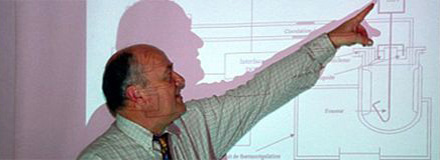Communications en 2005
L. Levavasseur, L. Rakotozafy, A. Sommier, J.-L. Baret, F. Arnaut, J. Potus et J. Nicolas (2005)
Mesure de la consommation d'oxygène et des échanges thermiques qui se produisent au cours du pétrissage au moyen d'un pétrin pilote instrumenté. Utilisation de la méthodologie des plans d'expériences.
Chimiométrie 2005, 30 novembre - 1 décembre, Villeneuve-d'Ascq, Poster.
Résumé : La méthodologie des surfaces de réponse a été utilisée pour étudier l'effet de la vitesse de pétrissage, de l'hydratation de la farine et de la température de départ des ingrédients sur l'oxygène consommé par la pâte et les échanges thermiques qui se déroulent au cours du pétrissage.
Mots-Clés : pétrissage - oxygène - échange thermique - méthodologie des surfaces de réponse.
(Texte : fichier pdf)
J. Nicolas(2005)
Oxygen consumption during mixing of wheat dough.
Conférence présentée le 10 novembre 2005 à l'université technique de Garching (Munich) après l'invitation du Dr. Peter Koehler (Deutsche Forschungsanstalt fuer Lebensmittelchemie - Lichtenbergstrasse 4 - D-85748 Garching, Germany)
Abstract : Oxygen incorporation in the wheat dough is a key factor during mixing for the rheological properties of the dough and the organoleptic properties of the resulting bread. The different reactions (mainly enzymatic) which may be involved in this incorporation will be reviewed. The results obtained with an air-tight mixer developed in our laboratory and used to study the biochemical and physical parameters affecting oxygen consumption during mixing, will be presented.
L. Levavasseur, L. Rakotozafy, A. Jeanneau, J. Georis, H. Robert, B. Genot, J. Rouillé, G. Bloch, J.L. Baret, F. Arnaut, J. Potus, J. Nicolas (2005)
Laccase effects on dough characteristics
Communication orale, 4th European Young Cereal Scientist and Technologist Workshop, June 29-30 - July 1, 2005, BOKU, Heiligenstadt, Vienna, Austria.
Abstract : Oxidoreduction reactions play a key role in the dough properties. During mixing, oxygen is the co-substrate implicated in the oxidation of many components such as hydrosoluble thiols compounds, oxidable polyunsaturated fatty acids, phenolic compounds and ascorbic acid (when added). Therefore, an uptake of oxygen is observed during the mixing of flour-water doughs. Besides studies on the gluten proteins, the interest of studies on the pentosan fractions has recently increased. In particular the addition of exogenous laccase during mixing is potentially interesting for the bakery industries, principally due to its effects on reticulation reactions in the dough. To study this in more detail we used a Pycnoporus cinnabarinus laccase. The purified enzyme showed a better affinity for the ferulic and sinapic acids and was inhibited by NaCl. Using an instrumented bioreactor we measured oxygen consumption and torque evolution during the mixing of salty water-flour dough, in which laccase was added and we compared the results obtained with control curves. Total oxygen consumption and oxygen rate uptake in the initial phase of mixing were increased. An effect on the torque curve was also observed. The results obtained suggest that it might be interesting to study the physico-chemical parameters influencing the oxygen consumption and the torque variation. Then the attention could be paid on the evolution of biochemical components during mixing (oxidable compounds, aggregated macromolecules), coupled with rheological measurements on the dough.
J. Nicolas (2005)
Enzymes involved in redox systems during wheat dough mixing.
Conférence plénière, 4th European Symposium on Enzymes in Grain Processing, ESEGP-4, Nantes, June 6-8th, 2005
Abstract : During mixing, gaseous oxygen is incorporated in wheat dough. This incorporation induces several redox reactions which, for most of them, are controlled by enzymes either already present in wheat flour or intentionally added in the dough recipe. These reactions may highly modified the rheological properties of dough and therefore the quality of the resulting bread. After the presentation of the distribution of redox enzymes in wheat flour milling fractions, the parameters acting on the oxygen consumption during dough mixing will be reviewed. Then, the redox enzymes able to act on the lipid fractions, the protein fractions (via the thiol - disulfide exchange and via the tyrosine residues), the polysaccharidic fractions (via the ferulic acid residue) and on ascorbic acid will be presented and their actions discussed including the connections with some hydrolytic enzymes.
L. Levavasseur, L. Rakotozfy, E. Manceau, L. Louarme, H. Robert, J.-L. Baret, J. Potus and J. Nicolas (2005)
Discrimination of wheat varieties by simultaneous measurements of oxygen consumption and consistency curve of flour dough during mixing.
Poster, 4th European Symposium on Enzymes in Grain Processing, ESEGP-4, Nantes, June 6-8th, 2005.
Abstract: Oxygen consumption and torque evolution are recorded during mixing of wheat flours doughs using an instrumented mixing - reactor. Flours are also characterised by biochemical analyses, results of alveograph and farinograph tests and bread making performances. Some parameters defined from the obtained torque curves, assimilated to the consistency curves, can be correlated with farinograph data. In addition of the characteristics of the oxygen consumption curves, we investigate the extent to which the consistency curve parameters are able to differentiate among doughs made with flours issued from different wheat varieties.
Poster (fichier pdf)
C. Billaud, S. Cheriot, C. Maraschin, M.-N. Peyrat Maillard, J. Nicolas (2005)
Maillard reaction products : a possible alternative to the sulphites use in the prevention of enzymatic browning in raw and minimally processed apples ?
European Symposium on Apple Processing ou Colloque Européen sur la Transformation de la Pomme, 16 au 18 mars 2005, Rennes
Poster (fichier pdf)


